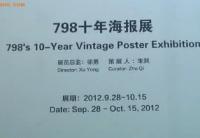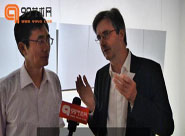Create from the Heart
As early as 1980’s, Zeng Peng from Foshan had held his individual exhibition of ceramic works in the National Art Museum of China and was since then known to the public as a ceramic master. In the 1990’s, Zeng Peng co-founded the “Yu Gong Kiln” with his brother. He took the lead in making furniture from sunken wood and now there are throngs of followers. But he remains unaffected by market competition and worldly concerns in his countryside workshop like a hermit. The products of “Yu Gong Kiln” established by him and his brother Zeng Li are so vivid, intriguing and varied in styles that they are far beyond the reach of their numerous imitators. Their winning secret probably owes to the fact that all the products are hand made by the artist himself and the creation is from his pure and accommodative heart. Zeng takes craft as occupation and leads a simple leisurely life, neither indulging in the stale palate of traditional craft industry nor fettered by game rules in the art field. His excellent taste has been turned into reality as manifested by his behavior and activities in everyday life. Materializing pastoral sentiment and exhibiting elegance in popular art forms, he is honestly a person of both refined and popular tastes.
Born to a family of artist potters in Foshan, Zeng Peng entered Jingdezhen Ceramic Institute in 1978. His father, Zeng Liang, was a famous master ceramic artist in modern China as well as the former Director of Shiwan Artistic Ceramics Factory. Therefore Zeng Peng has been exposed to the essence of Chinese traditional culture and folk arts since his childhood. He had unconsciously combined traditional ceramic craft with modern formalism aesthetics in his early productions and gradually developed his unique personal style which is so unsophisticated, refreshing and vivid, featuring Chinese traditional flavor of both literati and folk artists. The artist naturally integrated his unique handwriting of exuberant variation and animated inspiration into various kinds of visual mediums such as ceramics, metal, wood and paper in terms of material, as well as indoor and outdoor in terms of space. In this respect, Zeng is a practitioner that engages himself in the social-economic community with his personal wisdom.
From original drawings to finished products, from painting deviating to design, Zeng’s works has kept its unique unsophisticated feature thanks to his peaceful mind throughout his decades of pottery making career. It is interesting that he laughingly named his ink paintings in these years “A Piece of Cloud”. While the market response to such “sketches by literati” really takes us aback. In an era when everyone is eager for instant success and quick profit, it is indeed a rare exception that the artist could survive and furthermore, enjoy life to the fullest in his plain way. Like most urban residents, we are so used to planning ahead for future development and worry about the uncertainties all the time. We are always anxious to establish something on this hot land while reluctant to dig deeper into the earth to get the nourishment we need, or perhaps all our mother land need is merely respect she deserves. On the other hand, the reality seems to have taught us again and again that as long as one has money and power, he/she can manipulate everything in this world and what else is needed would just be time and means. We can no longer live in the present moment with peace; instead we are constantly making preparation for the future. Zeng is someone that indulges himself in imagination. He always imagines the world in his own way and then depicts the imagined world as if it were real. Personally I tend to interpret the Zeng Peng phenomenon, i.e., lyrics against the backdrop of advanced digital era, from the perspective of “visual humanics” – country field, water-ink painting, potteries and figurines produced by the Yu Gong Kiln, workers in the workshop and their children, rumble of the machine polishing the sunken woods, a delicately decorated yard, a koi pond, tea, a Danish dog named black mouth or big feet, Guqin (ancient lute).
The present day is constantly in the move, keeps updating in transience. It changes in the eyes of each of us and everyone has to be ready to face the constant changes in situations that involve one person and another, or people and objects. Zeng’s works obviously depict situations of the latter, which features a clearcut and straightforward lifestyle. If handwriting can be taken as an extension of the hand, it can also be viewed as a technique that is directly linked with one’s body and soul, which will never be abandoned once adopted. In his daily leisure activities such as painting, pottery making, string playing, tea drinking and gardening, Zeng comes back to the origin of creating from the heart. It would seem ridiculous to criticize Zeng’s works by conventional academic standards, since he never adheres to his own little world nor does he desire to wander in the commercial art field. Moreover, his works, or say products, are never intended to sell a good price or win a prize. All he wishes is to share with someone who really understands and appreciates them. Keeping a lifestyle in parallel with his character, he seems to be endowed with the air of a “Hindrance-free Buddha”.
Zeng always paints first before he makes pottery. His paintings usually draw on folk art, fairy tales, indigenous folkways, southern customs, etc. and have established a unique style that is unconfined by any existing conventions. I remember everytime I saw him paint, I would thought he was doing kind of land measuring (while his pottery making was like playing with building blocks). He just thrust the brush in all directions, spilling the ink here and there randomly, and finally finished the piece of work in a stroke. His ceramic products and wood sculptures are made in a similar way. The breath emanating from his works always trigger the viewers’ yearning for his unique lifestyle. An undefined word occurred to me – “post folk art”. The “post folk art” phenomenon involves folk music, folk film and folk arts festival that take place independently as individual art form. My understanding of the post folk art today refers to the artists that survive the economic wave in the current era, stick to the traditions and folk arts, and have strong individual artistic features. Their works convey the smell of the soil under our feet, song from the treetop, fresh air in the mountain woods as well as the soul of every living thing. The traditions and folk arts, having been spontaneously meliorated by the artists, become an edge tool that faces this era on the other side to keep the balance and transform the survivors in its unique way.
Zeng Peng creates from the heart, just to enjoy himself instead of pleasing anyone else, leaving his name writ in water.
Zeng Peng has been my friend and my mentor for a long time.
Liu Qingyuan
【编辑:singer】

